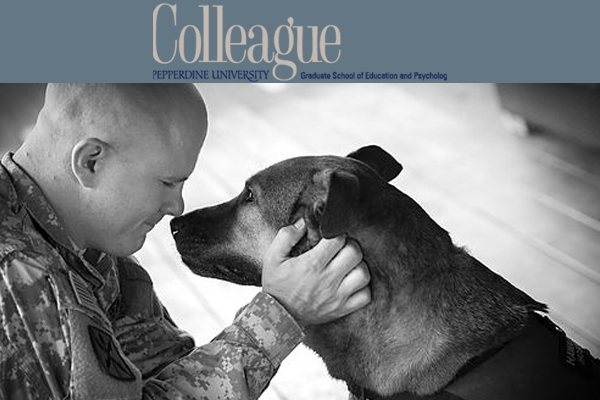January 29, 2019
Man’s Best Counselor
By, Dr. Shannon Curry
The first known use of dogs for therapeutic purposes was in 1919, when the U.S. secretary of the interior Franklin Lane, suggested that canines be incorporated into the psychiatric treatment at St. Elizabeth Hospital in Washington, D.C. This was followed by the implementation of Animal Assisted Therapy (AAT) services at New York’s Pawling Air Force Convalescent Hospital in 1942, where interactions with dogs were encouraged to speed recovery from injuries and to assist individuals who were experiencing symptoms of what we would diagnose today as post-traumatic stress disorder (PTSD).
In the years since, a continued history of dogs helping man, as well as growing body of scientific evidence, suggest that in addition to being man’s best friend, dogs may just be man’s best counselor.
Early on in my education at GSEP, Miguel Gallardo, PsyD, taught me that traditional Western methods of therapy can prevent us from reaching a large number of people who have experienced trauma. Despite significant efforts to eliminate stigma around mental illness and to encourage mental health care for those struggling with PTSD, in working with service members, I’ve noted the existence of an underlying view of PTSD as weakness. For many, seeking help for PTSD symptoms is not only an admission of said weakness; it may also be detrimental to their careers.
In light of all this, when Tiffany Kawaguchi, OTD, founder of Hawaii State Hospital’s Animal Assisted Therapy program, asked me to join the board of her nonprofit service dog organization, the Hawaii Canine Assistance Network (Hawaii CAN), and to develop a volunteer program for service members in the Warrior Transition Battalion (WTB), I jumped at the chance.
Service members appeared to benefit immensely from the unconditional love and affection that they received from the dogs—an experience starkly contrasting the perpetual feelings of guilt, shame, and self-doubt that characterize trauma.
Today, I continue to offer animal-assisted therapy services in my practice, and am happy to report what seems to be an increasing trend in the number of active-duty service members who are willing to seek treatment for PTSD symptoms. They often tell me that they read about my four-legged partner Gunnar on my website, which made them want to know more about animal-assisted therapy.
I’m okay with Gunnar being the reason they come to my door. Sometimes the best counselors are the least complicated.
Click here to read the original article in Pepperdine Colleague Magazine






